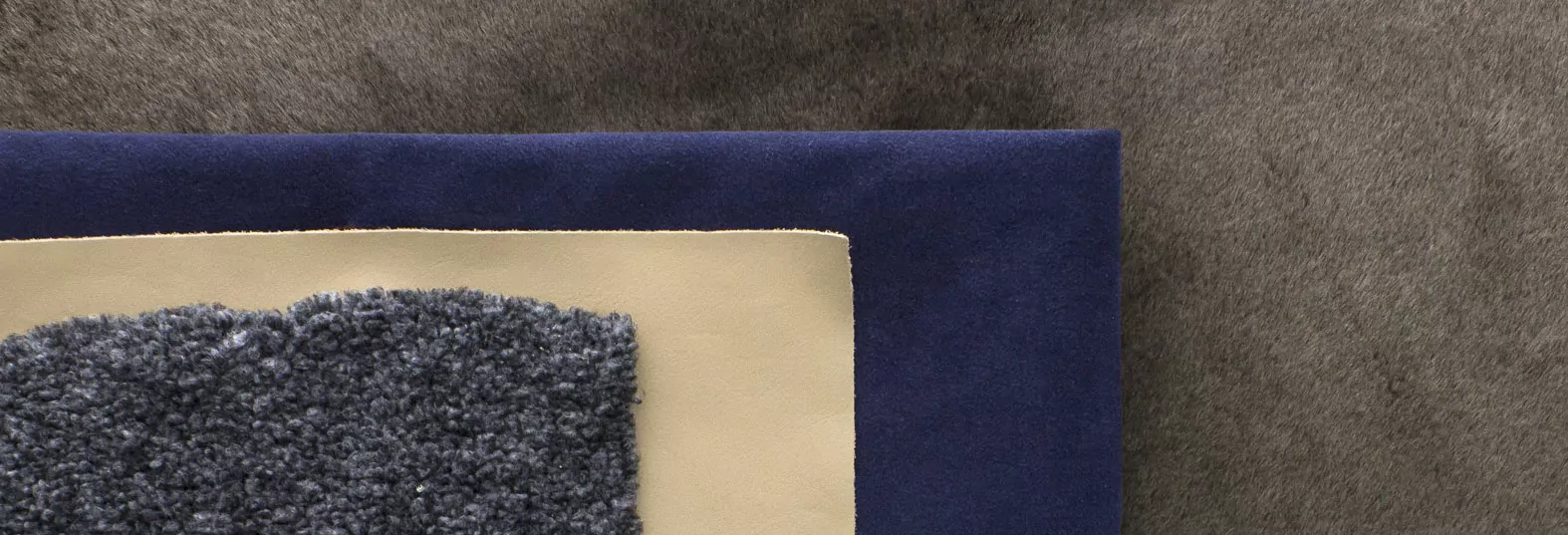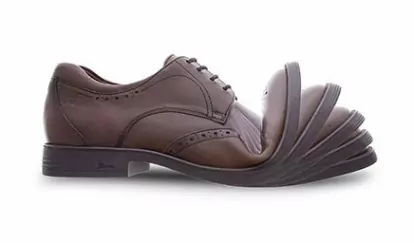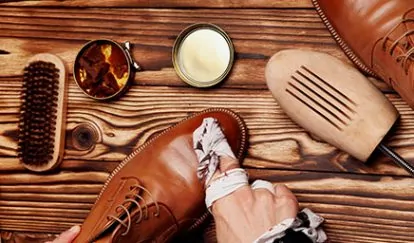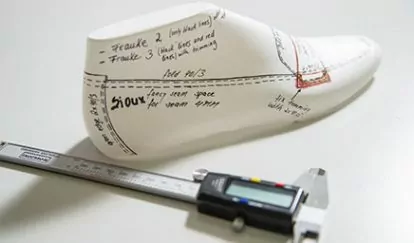SHOE LINING
It’s what is inside that counts

Consumers often only pay attention to whether they like a shoe and whether it fits well. What is inside the shoe should also be a decisive factor: the shoe lining is often underestimated when buying shoes, despite being a key factor when it comes to comfort and health. Below we will explain the various types of shoe lining, their uses and the importance of shoe lining when it comes to your well-being.
The importance of shoe lining
As the shoe lining comes into direct contact with the foot, the quality of the lining and its properties are very important. The lining of a shoe surrounds the foot from all sides and its job is to keep your foot warm and dry whilst optimally regulating the moisture balance inside the shoe. Unsuitable or poor-quality shoe lining can lead to increased sweating and unpleasant odours, especially if the shoe lining is made of synthetic material. Indeed, unsuitable shoe lining can also lead to pressure and chafing of the feet, which can worsen or even cause certain foot ailments, therefore putting strain on your feet and ultimately the rest of your body. Whilst we are on the topic of putting your body under unnecessary strain: it goes without saying that any lining you use must be free of toxins and pollutants. As one of the few German manufacturers with their own production sites in Europe, these things are a matter of course here at Sioux.
The classic shoe lining: genuine leather lining
The most natural shoe lining is leather. Premium-quality shoes, such as Sioux’s footwear, are mainly lined with calfskin leather. Additionally, the insole (i.e. the material on which your foot is placed) is mostly made of leather. In the mid-range segment, pigskin is often manufactured into lining material for cost reasons instead of calfskin leather; this does not apply to Sioux. Sioux does not use pigskin in any of its shoes, not even for the insoles. As it goes, even those with no knowledge about leather would be able to recognise this if they looked closely: pigskin has small dots on the surface where the bristles once grew. These dots are still visible to the naked eye on the leather lining or the insole. Retailers in the low-price segment (goods from large chain stores and discounters) use imitation leather or synthetic materials almost exclusively for their shoe linings, in order to keep their costs low.
The advantage of leather lining is its excellent breathability and moisture absorption capabilities. Leather is the only lining material that can absorb up to three times its own weight in water. Leather is therefore superior in terms of breathability and moisture absorption, even when compared with high-tech materials such as microfibre, due to the fact that it consists of tiny fibres and features open pores. People who sweat easily or whose feet sweat profusely should take care to purchase genuine leather for the inner lining of their shoes. More about this topic can be found in our blog entry „10 tips to prevent foot perspiration„.
Incidentally, leather lining is also optimally suited for wearing shoes barefoot in the summer. In addition, leather has the advantage that it is breathable, skin-friendly, supple, crack-resistant, robust, durable and retains its shape well.
Modern shoe lining: microfibre
Microfibre is the technical term for very fine fibres, which are characterised by a particularly small diameter and extremely low weight (it is hard to believe, however, the fibre diameter of microfibre is about one tenth of a head hair and 10km of microfibre weighs less than 1 gramme). Consequently, when microfibre is woven to create a textile, it has a very large surface area and therefore absorbs moisture well. That is why microfibre is well-suited for shoe linings. The microfibre materials used by Sioux are breathable and odour-resistant. They ensure a pleasant wear climate and keep the inside of your shoes dry. All microfibres used by Sioux are pollutant-free and hypoallergenic. All these features make microfibre an all-round talent when it comes to lining materials. One small downside: these properties are still nothing in comparison to genuine leather, which boasts even better moisture absorption and moisture-wicking capabilities. Microfibre is also cheaper than real leather, so it is often used when the very premium leather material would make the shoe too expensive. It is, however, a good compromise when it comes to weighing up the costs and benefits.
Insulated shoe lining: insulated lining
Winter is the season when people struggle to keep their feet warm. A good insulated lining in the shoes helps to counter this issue. The insulated lining used by Sioux is made of wool or textile fibres (like those used for stuffing teddies, for example). Wool or textile lining is particularly lightweight and warm at the same time. Similarly to natural fur, an insulating effect is achieved by creating an insulating layer of air between the fibres. The combination of air pockets and textile fibres keeps your feet warm in the insulated lining – without sweating. This climate control is great for keeping your feet healthy and makes the shoes an ideal companion for your daily routine. Another advantage of modern lining materials, such as insulated lining, is that the material can be optimally matched to the needs of the wearer and the uses of the shoe lining. That is why with every shoe you purchase from us, you receive an optimal lining that matches the shoe perfectly in terms of its aesthetic, feel and wear properties. Textile-based or wool-based insulated lining is often used in shoes when a lining made of real fur is not needed or it would make the cost of the shoe too expensive.
The fluffy lining: lambskin lining
This belongs to the top tier of inner lining for shoes. Sioux only uses materials that are by-products of livestock or food production, for all of its leather and fur, so that no animal is killed solely for the purpose of any Sioux shoe or boot. We only use genuine lambskin for our inner linings. They provide our customers with the cosiest, warmest and most luxurious way to get through the cold season.
Fur is simply a miracle of nature, it is 100% natural and boasts phenomenal material properties. Have you noticed: in spite of all the high-tech materials that humans have invented, those tackling extreme conditions today (e.g. expeditions in the high mountains or polar expeditions) still opt to wear real skin/fur products, namely in their boots and at the collar/head area, whenever it is crucial to be equipped with a reliable, high level of insulation which also features high breathability. So despite of all the advancements, the products of mother nature still shine through as the best.
The feet are optimally warmed thanks to the excellent properties of the real lambskin. In addition, this natural material is incredibly soft and adapts perfectly to your foot. Incidentally, one of the world’s most major lambskin producers is New Zealand, which is where Sioux sources most of its lambskins. With regards to processing lambskin, like all the materials we use, we pay as close attention as possible to the origin and sourcing of the goods.
OUR PRODUCT RECOMMENDATIONS FOR YOU
Shoe construction techniques
Why are there so many different shoe models? The construction technique used by Sioux depends on what the shoe will be worn for and what the wearer requires from it. Because, ultimately, the shoe must have a perfect fit.
Things you should consider when buying shoes
The following 10 tips will give you a practical guide and help you with your next shoe purchase. Besides the right shoe size and width, an optimal fit, skilful workmanship and the use of high-quality materials for the upper, lining and outsole are also important factors when it comes to quality and selection. We want you to stay feeling comfortable in your shoes for as long as possible.
Crepe sole
Learn more about what is undoubtedly the most natural form of comfort - everything about this Sioux speciality can be found here.
Labelling of materials
A question frequently asked by our customers is: “How can I be sure that the material used is really genuine leather?"
The history of footwear
More than 40,000 years ago, people developed a need to protect their feet against adverse external conditions. It took several centuries, however, until the fashionable and comfortable footwear that we are familiar with today became available.
Sioux hallgus protect
The combination of high-quality leather and our innovative Sioux-Tex climate membrane will give your feet that “feel-good” feeling: whilst moisture and vapour are quickly wicked away from the shoes, water from the outside has no chance of getting in, meaning your feet are always warm and dry.
Sioux natural move system
The combination of high-quality leather and our innovative Sioux-Tex climate membrane will give your feet that “feel-good” feeling: whilst moisture and vapour are quickly wicked away from the shoes, water from the outside has no chance of getting in, meaning your feet are always warm and dry.
SiouxTex
The combination of high-quality leather and our innovative Sioux-Tex climate membrane will give your feet that “feel-good” feeling: whilst moisture and vapour are quickly wicked away from the shoes, water from the outside has no chance of getting in, meaning your feet are always warm and dry.
Shoe lining
Consumers often only pay attention to whether they like a shoe and whether it fits well. What is inside the shoe should also be a decisive factor: the shoe lining is often underestimated when buying shoes, despite being a key factor when it comes to comfort and health. Below we will explain the various types of shoe lining, their uses and the importance of shoe lining when it comes to your well-being.
Shoe soles
Whether they are a lightweight and flexible, feature unique air-cushioning or have a timeless and elegant leather sole: it's the perfect join of the shoe upper and sole which is the finishing touch to each and every shoe.
Shoe size and fit
As the foot performs a rolling motion when walking, it bears your weight in various areas and thus changes shape in doing so. The hallmark of a perfect-fitting shoe is that the toes and the foot itself have enough space within the shoe throughout this rolling motion and that the heel experiences sufficient grip. When a shoe fits, the heel does not slip out of the back of the shoe, and the shoe sits so perfectly in the midfoot area that the foot is supported – and is unable to slip forwards – hence the shoe pinching.
Shoe leather
Choosing the leather is very easy when it comes to Sioux shoes: we only settle for the best.
Shoemaking
There are lots of steps involved in making a shoe. From developing the model in the first instance, to the stamping, sewing and putting the finishing touches to the shoe at the very end.
Grashopper
In the 1960s, the natural form moccasin was a revolution. Today, the cult shoe is more topical than ever as a pioneer in modern casual wear.
 DE
DE EN
EN FR
FR NL
NL















